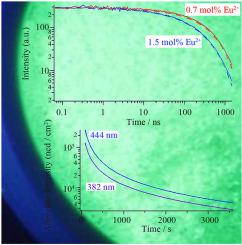Journal of Rare Earths ( IF 5.2 ) Pub Date : 2021-07-28 , DOI: 10.1016/j.jre.2021.07.014 Bernhard Walfort 1 , Nando Gartmann 1 , Jafar Afshani 2 , Arnulf Rosspeintner 2 , Hans Hagemann 2

|
The persistent phosphor SrAl2O4:Eu2+,Dy3+ is the subject of numerous investigations. One often neglected aspect is that in this phosphor, as well as in Sr4Al14O25:Eu2+,Dy3+, there are two different Sr2+ sites which can be occupied by the dopant Eu2+ ions. We first introduce a general scheme of possible energy transfers in these persistent phosphor materials including explicitly both europium ions. This scheme is used as a generic starting point to study experimentally specific pathways. We illustrate this application with the study of the effect of excitation wavelength (444 and 382 nm) on the afterglow of differently doped SrAl2O4:Eu2+,Dy3+ samples, as well as on the emission decay curves. With the same excitation intensity under 444 nm excitation, the resulting afterglow intensity is stronger than under near UV excitation. At 382 nm, Eu2+ ions on both Sr2+ sites in SrAl2O4 are excited, but at room temperature the blue emission is quenched, leading to a loss of photons. The observed effects can further be associated with the ratio of Eu2+ ions and trap states which are modulated by the concentrations of Eu2+ and Dy3+ in SrAl2O4, as well as by temperature. Increasing the nominal Dy3+ content from 0.1 mol% to 0.5 mol% with respect to Sr results in the doubling of the integrated afterglow intensity and confirms thus that Dy3+ ions are indeed involved in the trapping process. The concentration of trap states is much lower than the concentration of Eu2+ ions, as even with low excitation densities, a plateau of integrated afterglow intensity (corresponding to the total number of accessible traps) is reached. We postulate that an important fraction of excited Eu2+ ions can potentially transfer their energy to trap states. Once that all traps are filled or in a dynamical filling-depletion process under illumination (with thermal and/or optical depletion processes), for the remaining Eu2+ a “normal” steady-state emission is observed. The luminescence decay curves at 520 nm measured at 77 K show a mono-exponential decay with a common lifetime of about 1140 ns for all 5 samples under 437 nm excitation, while under 375 nm excitation, a feed process originating from the energy transfer between Eu2+ ions is demonstrated. Under 375 nm excitation, the non-exponential decay observed at 440 nm can be quantitatively associated to a Förster energy transfer process with R0 = 1.58 (8) nm. For the overall understanding of the afterglow processes, it appears that one has to consider the individual contributions of all active ions on different lattice sites.
中文翻译:

激发波长(蓝色与近紫外)和掺杂剂浓度对持久性荧光粉 SrAl2O4:Eu2+,Dy3+ 的余辉和快速衰减的影响
持久性磷光体 SrAl 2 O 4 :Eu 2+ ,Dy 3+是众多研究的主题。一个经常被忽视的方面是,在这种荧光粉中,以及在 Sr 4 Al 14 O 25 :Eu 2+ ,Dy 3+中,有两个不同的 Sr 2+位点可以被掺杂剂 Eu 2+占据离子。我们首先介绍了这些持久性磷光体材料中可能的能量转移的一般方案,其中明确包括两种铕离子。该方案用作研究实验特定途径的通用起点。我们通过研究激发波长(444 和 382 nm)对不同掺杂 SrAl 2 O 4 :Eu 2+、Dy 3+样品的余辉以及发射衰减曲线的影响来说明该应用。在 444 nm 激发下的相同激发强度下,产生的余辉强度比近紫外激发下的强。在 382 nm 处,Eu 2+离子在 SrAl 2 O 4的两个 Sr 2+位点上被激发,但在室温下,蓝色发射被猝灭,导致光子损失。观察到的效果可以进一步与Eu 2+离子和陷阱态的比率相关联,后者受SrAl 2 O 4中Eu 2+和Dy 3+的浓度以及温度调节。相对于 Sr将标称 Dy 3+含量从 0.1 mol% 增加到 0.5 mol% 会导致积分余辉强度加倍,并因此证实 Dy 3+离子确实参与了捕获过程。陷阱态的浓度远低于Eu 2+的浓度离子,即使在低激发密度的情况下,也会达到综合余辉强度的平台(对应于可访问陷阱的总数)。我们假设很重要的一部分激发的Eu 2+离子可以潜在地将它们的能量转移到陷阱态。一旦所有陷阱都被填充或在光照下(具有热和/或光学耗尽过程)处于动态填充-耗尽过程中,对于剩余的 Eu 2+,观察到“正常”稳态发射。在 77 K 下测量的 520 nm 处的发光衰减曲线显示,在 437 nm 激发下,所有 5 个样品的共同寿命约为 1140 ns 的单指数衰减,而在 375 nm 激发下,进料过程源于 Eu 之间的能量转移2+离子被证明。在 375 nm 激发下,在 440 nm 观察到的非指数衰减可以定量地与R 0 = 1.58 (8) nm 的 Förster 能量转移过程相关联。为了全面了解余辉过程,似乎必须考虑不同晶格位置上所有活性离子的个体贡献。











































 京公网安备 11010802027423号
京公网安备 11010802027423号